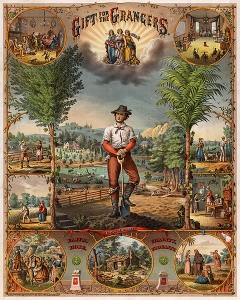
Winslow Homer (1836-1910)|Spring Farm Work—Grafting, 1870|Illustration for Harper’s Weekly XIV (April 20, 1870): 276|Wood engraving from a drawing by Homer; signed in the block, on the tree trunk, “W. H.”
Spring Farm Work—Grafting, is one of a variety of painted and illustrated images Winslow Homer created after the Civil War exploring American rural New England and upstate New York farm life: from the Veteran in a New Field, 1865 to Milking Time, 1875. This illustration on grafting is a bit different from the rest in that it is focused on displaying a specific farming practice. The technique of grafting is a way to encourage the growth of a fragile plant by melding it with a sturdier specimen. It is also sometimes used to produce a hybridization of two types of the same species. The form of grafting Homer illustrated here is called “top-worked” or a “cleft graft,” indicating the replacement of the top of one plant with buds of another. The cleft graft is used for top-working older established apple and pear trees, either on the trunk of a small tree or on the side branches of a larger tree.
By placing the illustrated scene up in the branches of the tree, Homer details the process of attaching a graft onto the growing layer of another tree, showing the special knife needed for the job as well as the preparation of the woody shots bearing the buds. Hanging from the branch on which the farmer is making the graft is a bucket of tools needed for the job. Grafting typically takes place in the spring, allowing the merging of the stock and scion (the graft being applied to the base) a long growing season to “take,” hence this illustration was published at the end of April, the beginning of the season. Even though the image is about this farm activity of the spring, Homer’s farmer has removed his suspenders from his shoulders, as though their pressure made his sweaty shirt uncomfortable. The strength of the day light is emphasized by the shadows cast by the farmer’s hat and the front of his right leg standing on the ladder rung. The scene’s paler background details of hayricks, farm buildings, and a sprinkling of geese and chickens, remind the viewer of the wider range of farm activities the farmer pursues.
Homer’s Grafting seems to also represent an aspect of the program supported by the American farm organization, The Grange, founded in 1867. The Grange advanced famers’ economic and social interests, and, at the same time, used its institutional power to combat rising costs after the Civil War, which were the result of rate increases for grain elevators and railroad freight.* An 1873 chromolithograph promoting the Grange (see below) includes images of the American landscape’s transformation by removal of forests, extended cultivation of crops and animal husbandry, and other farm activities such as haying and grafting. The grafting portion of this poster image is on the right edge in the upper middle of the page.

Gift for the grangers, c. 1873|J. Hale Powers & Co. Fraternity & Fine Art Publishers, Cincinnati|Strobridge & Co. Lith. Cincinnati, Ohio|Library of Congress, Prints and Photographs Division, Washington, D. C
Winslow Homer would have made the drawing his illustration is based upon, while another craftsman, a wood engraver employed by the publishers, would have been responsible for carving the wood engraving block from which the print was made. The drawing would either have been laid onto the fine grained boxwood or redrawn onto the woodblock. The engraver would cut away the blank spots on the surface, leaving the raised line that would in turn be printed as the image. As far as is known, Winslow Homer never cut a wood engraving block himself.
Homer’s continuing interest in life and activities on single-family farms reflects the North’s view of itself from even before the Civil War. His farm engravings, created during the period of southern Reconstruction after the war, pointedly imply that single-family farm northerners are focused on grafting fresh life onto their farms.
* Oliver Hudson Kelley was an employee of the Department of Agriculture in the 1860s. He made an official trip through the South and was astounded by the lack of sound agricultural practices he encountered. Joining with other interested individuals in 1867, Kelley formed the National Grange of the Patrons of Husbandry, a fraternal organization. The Grange rapidly expanded, achieving a membership of nearly one million by 1875. See Encyclopedia Britannica (1962): X, 631.
May 6, 2010
By Joyce K. Schiller, Curator, Rockwell Center for American Visual Studies
at the Norman Rockwell Museum






